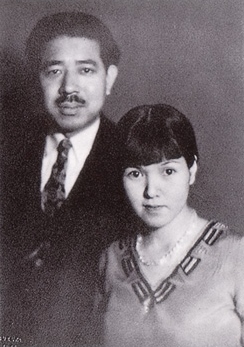Ayako Ishigaki facts for kids
Quick facts for kids
Ayako Ishigaki
|
|
|---|---|
| 石垣 綾子 | |

Ayako and Eitaro Ishigaki in 1927
|
|
| Born | 1903 Tokyo
|
| Died | 1996 |
| Spouse(s) | Eitaro Ishigaki (married 1931–1958) |
Ayako Ishigaki (石垣 綾子, Ishigaki Ayako, 1903 – 1996) was a Japanese journalist, activist, and feminist. She was one of the first Japanese American women to publish a book about her own life in English.
Contents
Ayako Ishigaki: A Life of Change
Early Life and Moving to America
Ayako Ishigaki was born Tanaka Ayako in Tokyo, Japan, in 1903. Her father was a college professor. In the 1920s, she started getting involved in politics.
In 1926, Ayako first came to the United States. She traveled with her sister, whose husband was a diplomat working in Washington, D.C. Soon after, Ayako moved to New York City. There, she took classes at Columbia University. In New York, she met a painter named Eitaro Ishigaki. They got married in 1931.
Speaking Out Through Writing
After Japan's military invaded a part of China called Manchuria in 1931, Ayako Ishigaki spoke out against it. She wrote articles about Japan for a magazine called The New Masses. Her articles talked about the bad effects of powerful countries trying to control weaker ones. She also wrote about how new factories and technologies affected Japanese workers, especially women.
During this time, she used a fake name, Haru Matsui. This was to protect her family in Japan from trouble because of her activism. In 1937, she moved to Los Angeles. There, she wrote a column every two weeks for a Japanese American newspaper called Rafu Shimpo. For this, she used another pen name, May Tanaka. Her columns focused on daily life. They also included ideas about equal rights for women and against war. She returned to New York later that year. In 1938, she went on a tour giving talks with a modern dancer named Si-Lan Chen. During one of her talks, a publisher asked her to write a book.
Restless Wave: A Special Book
Ayako Ishigaki's book about her life, Restless Wave: A Life in Two Worlds, came out in January 1940. She published it under the name Haru Matsui. Many famous magazines like The New Yorker reviewed it. The book was about her life story. Later, she said it was a "novelistic semi-autobiographical text." This means it was a story about her life that was a bit like a novel. It mixed real events with some creative storytelling.
Restless Wave became popular in the U.S. But her strong criticisms of Japanese society and its military made the Japanese government unhappy. The book also led to a friendship between Ayako and American author Pearl S. Buck. Pearl S. Buck liked Restless Wave and asked Ayako to write for Asia magazine.
Facing Challenges During Wartime
When the U.S. and Japan went to war in 1941, Ayako and Eitaro had to register as "enemy aliens." This meant they were from a country the U.S. was fighting. Even though they lived on the East Coast and were not sent to special camps like many Japanese Americans on the West Coast, they still faced difficulties. They had curfews and their homes were searched. They also lost their jobs. In 1942, Ayako started working for the Office of War Information. This was a U.S. government agency during World War II.
Back in Japan: A Voice for Women
In the late 1940s, the Cold War began. In the U.S., there was a strong fear of communism. Because Ayako and Eitaro had been involved in groups that wanted social change, the government watched them. In 1951, Eitaro was arrested and sent back to Japan by the American government. Ayako went back to Japan with him.
After returning to Japan, Ayako kept working as a journalist, speaker, and translator. In 1955, she wrote an article called "Housewife: The Second Profession." In it, she encouraged Japanese housewives to find fulfillment outside the home. This article started a big discussion in Japanese media, called the 'housewife debate'. She continued to write many books, about thirty in total, and became a television commentator.
See also
- Japanese American Committee for Democracy
- Japanese dissidence during the Shōwa period
- Feminism in Japan

